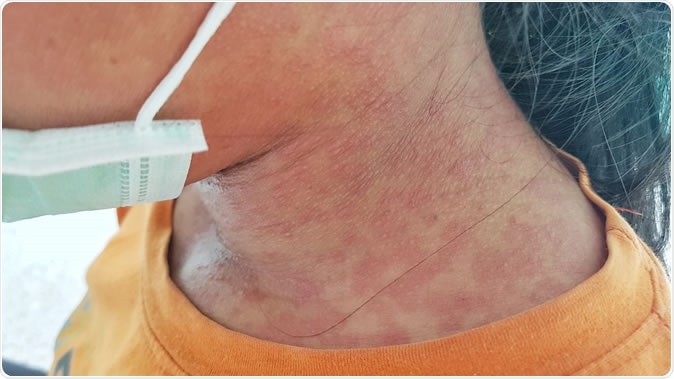A new study carried out by the World Health Organization and the Centers for Disease Control and Prevention (CDC) says that a historic milestone has been crossed – over 50% of the world’s babies are now safe from rubella, or German measles. The disease has not been detected for a year or more in more than 80 countries all over the world. This has been achieved by increasingly broad coverage of the child population in lower-income countries with rubella vaccine – a safe and highly effective vaccine which protects over 95% of vaccinees against the disease.

Rubella patient. Image Credit: Akkalak Aiempradit / Shutterstock
Rubella is actively targeted in children not because of its clinical severity but because of the problems that it can cause to the unborn fetus if it affects a pregnant woman. Indeed, it is among the mildest of viral infections, often passing completely unnoticed, or with just a light rash that disappears within 3 days at most. However, in early pregnancy rubella, the chances are 90% that the virus will enter the baby’s developing tissues as well. This can leave the baby dead or severely devastated, with multiple congenital defects in the heart, eyes and ears – including a characteristic congenital rubella syndrome (CRS) – as well as a future of lifelong disability.
CRS includes deafness (present in two-thirds), autism, diabetes and thyroid dysfunction, which require lifelong care and/or expensive and highly sophisticated medical treatment. The incidence of the disease in former prevaccine times was as high as 4/1000. In fact, 1964 saw a major epidemic with 12.5 million rubella infections and 20,000 CRS babies – not to mention more than 11,000 stillborn babies and miscarriages. Today, CRS is most likely in countries with poor vaccination coverage, where the virus can still spread to women who are in their reproductive years.
Rubella is highly contagious, and requires a high degree of population coverage. The vaccine is a live attenuated vaccine and provides long-term immunity. Both monovalent and polyvalent vaccines are available, the former containing only rubella while the other contains additionally measles, mumps and/or varicella vaccine. The vaccine is safe and usually well-tolerated.
Yet, the study warns, this is not room for complacency, as the virus can quickly resurface if the rate of vaccination slips down significantly. Researcher Shalini Desai says, “The only way to ensure protection against rubella is to make sure that all children are vaccinated against it, alongside surveillance systems that are strong enough to quickly detect cases and respond rapidly to stop the spread - especially to pregnant women.”
At present, about 100,000 children are born with CRS every year. To keep this number down and eliminate the infection from more countries, public health organizations want rubella vaccine to be included in national immunization programs – as is already occurring in 168/194 WHO member states. Typically it is given in combination with mumps and measles vaccine to allow such incorporation.
The second step includes robust disease surveillance programs that will keep tabs on the emergence of the virus every time it occurs, so as to track possible upsurges as and when the disease is imported into a setting where it had become rare.
The elimination of rubella is in tune with the Global Vaccine Action Plan (GVAP) that is aimed at preventing millions of vaccine-preventable deaths by providing universal access to high-quality vaccines by 2020. As of now, however, this plan is not working as well as expected.
In the case of rubella, the primary issue is with 26 countries, mostly in Africa, which the rubella vaccine is not part of the schedule. Actually, 60% of African countries do not provide free rubella vaccine. These 26 countries account for almost a third of children worldwide.
Political will and community-level leadership will be required to achieve disease elimination. At present, almost 70% of infants are protected, compared to 47% in 2016. The WHO reports that the number of rubella cases has gone down by 97% from 2000 to 2018, but coverage is lowest, and CRS incidence highest, in Africa and some parts of South-East Asia. The WHO response is in part the launching of the Measles Initiative, now renamed the Measles & Rubella Initiative, under which measles and rubella are planned to be eliminated in at least 5 WHO regions by 2020. The WHO’s Strategic Advisory Group of Experts (SAGE) on Immunization has recommended making the rubella vaccination part of the routine immunization. The WHO advises focusing on routine as well as targeted immunization to completely protect the world’s children, present and future, against this insidious enemy which is robbing thousands of children.